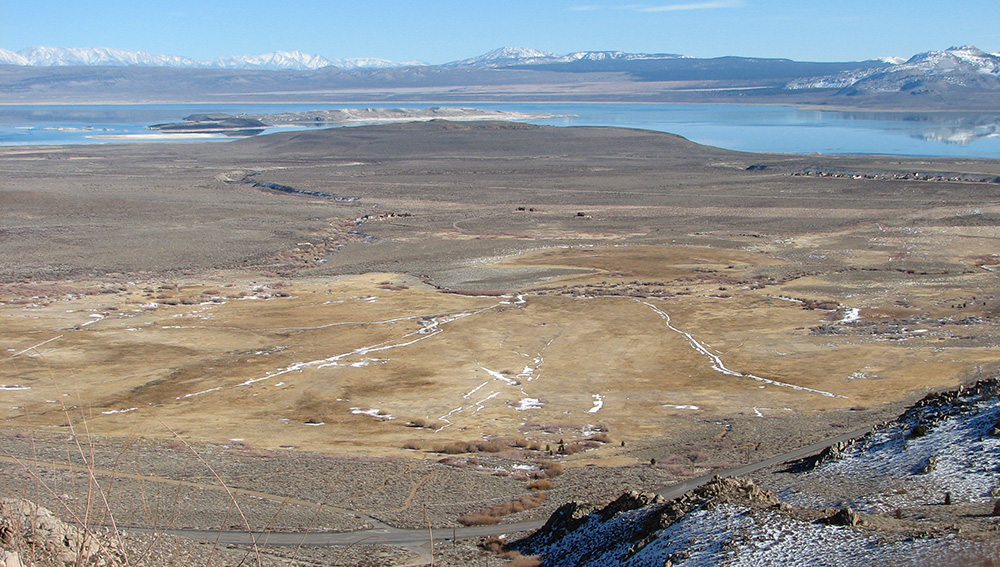
This post was written by Lisa Cutting, 2002-2020 Eastern Sierra Policy Director, 2000-2001 Environmental Resource Coordinator, and 1999 Mono Lake Intern.
After two years of public meetings with diverse stakeholders, numerous field visits, and countless rounds of legal review and revision, the Conway Ranch Conservation Easement was signed and recorded by the Eastern Sierra Land Trust (ESLT) and Mono County on December 1, 2014.

The two parties successfully worked out myriad easement details with the dual goals of protecting open space and wildlife habitat while allowing for limited economic activities, specifically fish rearing and sheep grazing.
The easement is cause for celebration—the protections it secures for this beloved, 800-plus-acre historic ranch are an important piece of the patchwork quilt of land management that covers the north Mono Basin.
Easement simplifies, clarifies protections
Grant money that Mono County used to purchase Conway Ranch in 2000 came from multiple sources—the California Department of Transportation (Caltrans), the California Department of Parks & Recreation, and the National Fish & Wildlife Foundation. Requirements from the grantors became a complex web of restrictions. The new easement has been endorsed by all of the original grantors and brings together all of the property requirements in one place.
Additionally, the easement provides a new layer of protection through a recorded deed on the property that will last in perpetuity. Among other requirements, the easement specifically stipulates a public management process that will happen by way of annual meetings and annual operating plans—both of which had been lacking in the past.
Next steps
With the goal of securing protection achieved, it is now critical to turn that accomplishment into action. Mono County continues to own and manage the property but it will be ESLT’s responsibility to monitor things such as the total number of acres of wetlands and use of water for allowed purposes, and to enforce the terms of the conservation easement. This is no small task.
Meanwhile, the County has begun working on the 2014 Annual Report and is finalizing an Operations Plan for 2015. These documents include details related to fish-rearing, irrigation, sheep grazing, and public access and recreation.
Committee’s involvement continues
Through the process, the Mono Lake Committee has been an advocate for balancing the natural values of the property—wetlands and springs, open space, migratory routes for mule deer, and Greater Sage Grouse habitat—with sheep grazing, fish-rearing operations, and public access.
The Committee was also an advocate for assembling the management details into a single unified document. Instead of deciphering multiple grant documents, all parties will now be using the easement as the ultimate guide, which is extremely helpful when it comes to on-the-ground management and oversight.
Mill Creek still awaiting its water
Through the decades-long process of protecting Conway Ranch, the land and wildlife haven’t seen much change—deer still migrate through, birds still seek out ponds and wetlands, and the historic ranch buildings still stand as sentinels over the property.
However, despite a 2005 Federal Energy Regulatory Commission mandate to rehabilitate the Mill Creek return conveyance, the project has not yet been realized and Mill Creek still does not flow with all the water that it is entitled to. This has caused widespread damage to the lower section of Mill Creek. The Committee would have liked to have seen stronger language related to Mill Creek water rights and the lawful distribution of Mill Creek water incorporated into the easement.
So, while we celebrate the achievement of a conservation easement on Conway Ranch, we are also well aware of the work that still needs to be done to protect and restore Mill Creek. Protection of the north Mono Basin won’t be complete until Mill Creek has the water that it needs to be a fully functioning and vibrant stream system.
This post was also published as an article in the Winter & Spring 2015 Mono Lake Newsletter.
